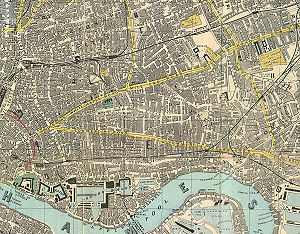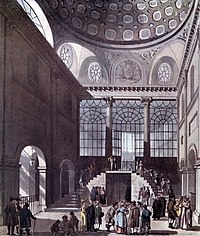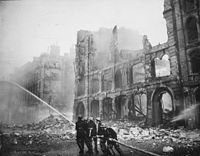History of Middlesex
Middlesex has a long and distinguished history. Although Middlesex is a small county geographically, the political and economic capitals of the kingdom are here and so much of Britain's history has happened in Middlesex.
The greatest noticeable movement in the history of Middlesex specifically has been its urbanisation, whereby houses and industry over the ages multiplied so that barely a green field is left here now other than at its outermost fringes and in its urban parks and the town squares of the gentry.
Contents
Early settlement
There were settlements in the area of Middlesex that can be traced back thousands of years into prehistory. The land which was to become Middlesex appears in recorded history with Caesar's second invasion in 54 BC; King Cassiovelaunus had sharpened stakes placed in the Thames, on the shore and beneath the water to prevent the Romans crossing, though in the event Caesar effected a crossing of the river. Excavations in Brentford in the twentieth century found a heavy stake in the clay which may have been one of those; whether it is or not, it remains in the Middlesex Guildhall Collection: a symbol of British defiance of arrogant foreign invaders.. The Romans, when they finally conquered under Claudius, were responsible first development of Middlesex, for while their Londinium was almost certainly on an existing town site, they effectively founded London, on the site of today's City. In their day, Londinium became one of the great cities of the Empire. The Romans built roads out of London all across Middlesex and villas appeared. Ad Pontes at Staines was a major Roman bridging point.
After the Romans fled Britain, its lands were settled by Saxons and in due course they became part of the by the Kingdom of Essex. In the 8th century, Middlesex was seized by the King of the Mercians, and Mercia retained it for the rest of that kingdom's endurance. It was in the Mercian period that we first here the name Middelseaxe ("Middle Saxons") in a charter of King Offa dated 704, granting an estate of land in Twickenham to Bishop of Waldhere,[1] appearing as Middleseaxan ("Middle Saxons"). How long the county had been known and by what name we cannot tell.
The economy of the county was dependent on the City of London from an early time and was primarily agricultural. All manner of goods were provided for the City, including crops such as grain and hay, livestock and building materials. Tourism in early resorts such as Hackney, Islington and Highgate also formed part of the early economy. However, during the 18th century the inner parishes of Middlesex started to function as suburbs of the City and were increasingly urbanised.
Urbanisation and suburbanisation
The spread of London over the fields of Middlesex worried some in government even in the days of Queen Elizabeth I. London of a hundred years later was described by Daniel Defoe in A Journal of the Plague Year, describing London in 1665; it was London was the City and its liberties, but spread to Westminster and east to the docks. The explosive growth of London was to begin in the eighteenth century with the development of new upmarket estates and the slums that fed them.
By the 19th century, the East End of London had expanded to the eastern boundary with Essex, and the Tower division had reached a population of over a million. Following the coming of the railways, the north-western suburbs of London steadily spread over large parts of the county.[2]
The coming of the railways
The introduction of radial railway lines from 1839 caused a fundamental shift away from agricultural supply for London towards large scale house building.[3] Tottenham, Edmonton and Enfield in the northeast developed first as working class residential suburbs with easy access to central London. The line to Windsor through Middlesex was completed in 1848, to Potters Bar in 1850 and the Metropolitan and Metropolitan District Railways started a series of extensions into the county in 1878. Closer to London, the districts of Acton, Willesden, Ealing and Hornsey came within reach of the tram and bus networks, providing cheap transport to central London.[3]
The new dynamic of the railways fundamentally changed the county: within a couple of generations Middlesex became almost entirely filled by suburbs of London, with a big rise in population density. This process was accelerated by the Metro-land developments, which covered a large part of the county.[4] Public transport in the county, including the extensive network of trams,[5] buses and the London Underground came under control of the London Passenger Transport Board in 1933 and a New Works Programme was developed to further enhance services during the 1930s.[2]
Green Belt
However the establishment of the Metropolitan Green Belt in the 1930s did a great deal to halt the apparently inexorable spread of urbanisation over the Home Counties, and as a result, the pockets of rural Middlesex at Harefield and South Mymms and the outer edges of the county have remained, while in the depth of the metropolis the royal parks and urban squares provide a weak echo of what once was.
New industry
The Industrial Revolution took Middlesex by surprise: from being the most economically advianced part of the land, it was overtaken by the vast steam-driven mills of Lancashire, Lanarkshire and the West Riding of Yorkshire, and it wasa remarked that London would be left isolated in a rural south.
After the First World War, the availability of labour and proximity to London made areas such as Hayes and Park Royal ideal locations for the developing new industries.[3] Electricvity made the difference; the machines in the factories of the north were powered by a great driveshaft the length of the mill, itself turned by steam, but London factories used electricity, giving them flexibility Lancashire could not match. As the twentieth century progresed, new jobs attracted more people to the county and the population continued to rise, reaching a peak in 1951.
Administrative innovation
The rapid urbanisation of Middlesex has made it a laboratory of experimentation in administrative innovation.
The City of London has been self-governing since before the Norman conquest; one of William the Conqueror's earliest charters was a charter in English confirming the rights of the city. During the Middle Ages the City created a mayoralty and gave a role in government to its trade guilds, both of which remain, and repeatedly adapted its ancient institutions to create the multiplicity of levels and institutions the Corporation still has. Richard I granted all Middlesex to the city in fee; the city governed Middlesex and appointed two sheriffs over it and collected its taxes in return for a fixed payment to the Crown. The right to appoint sheriffs ended only in 1889.
A series of Liberties appeared in Middlesex over the ages, which were exceptions to the usual forms of jurisdiction created to suit various interests. Westminster Abbey controlled the Liberty of Westminster, which became the City of Westminster. The Crown controlled the Tower Liberty around the Tower of London and the Rolls Liberty near the City. The Bishop of Ely's estate was a liberty (which remained even after secularisation as the Liberty of Saffron Hill around Ely Place). The Duke of Lancaster enjoyed the Liberty of the Savoy at his estate, which Liberty jealously guarded its rights into modern times.
The Justices of Middlesex were innovators too. King James I granted them a piece of ground in the middle of the highway at Clerkenwell and here, by the donation of Sir Baptist Hicks, they built a hall known as Hicks Hall - one of the first dedicated shire halls - so that they no longer had to hold sessions at the Castle Inn. In 1749 under Henry Fielding they created the Bow Street Runners, the first police force. In 1780 Hicks Hall, structurally decayed and no longer big enough for the ever-increasing work of the justices, was replaced by a grand Sessions House on Clerkenwell Green (which still stands in all its grandeur). The justices were very busy by this time keeping control of a county increasingly lawless, in particular around London and they gained a reputation for harsh sentences. The Middlesex justices were the only paid justices of the peace, until 1889.
Ossulstone Hundred contained the districts closest to the City of London and soon the Hundred institutions were overburdened; during the 17th century it was divided into four divisions, which, along with the City and Liberty of Westminster, largely took over the administrative functions of the hundred.
In 1829, the first official police force in Great Britain was created, the Metropolitan Police, with charge over London and its suburbs. In 1840, the entire county was included in the Metropolitan Police District.[6]
Local government in the county was unaffected by the Municipal Corporations Act 1835 which democratised town government elsewhere, and civic works continued to be the responsibility of the individual parish vestries or ad hoc improvement commissioners.[7][8] In 1855 the Metropolitan Board of Works was created to take charge of the dire state of public infrastructure in the metropolis around London. Despite this innovation, the system was described by commentators at the time as one "in chaos". The Board though gained a reputation for indolence and corruption.
In 1888 the minority Conservative-Liberal Unionist ministry of Lord Salisbury determined to replace the Metropolitan Board of Works with a new municipal council; in the event the Liberals in the House of Commons forced the creation of such councils in every county of England and Wales; thus in 1889 a new "administrative county" named "London" was created covering parts of Middlesex, Surrey and Kent, while the remainder of Middlesex had its own council. The London County Council governed the majority of Middlesex's population henceforth and the Middlesex County Council the rest.
The urbanisation of the county continued to widen far beyond the bounds of 1889. In the interwar years, urban London had further expanded, with increasing suburbanisation, improvement and expansion of public transport,[2] and the setting up of new industries outside the LCC area of inner Middlesex. After the Second World War, the population of this inner Middlesex area was in steady decline, with new population growth only experienced in the outer suburbs.[9] After a Royal Commission on Local Government in Greater London, The London Government Act 1963 was passed, which came into force on 1 April 1965, which Act abolished the administrative counties of Middlesex and London[10] and created a "Greater London Council", which endured until 1986. In all of Middlesex, just the very south-western parishes and Potters Bar in the north were left out of "Greater London".
The First and Second World Wars
Partly because of its proximity to the capital, the county had a major role during the Second World War. The county was heavily struck by the Luftwaffe; the Blitz burned the East End and the docks with particular cruelty and the City burned. The suburbs were largely unharmed, though they were struck by the doodlebugs and V2 rockets of the latter years of the war.
Various vital military establishments were settled in Middlesex such as RAF Uxbridge and RAF Heston, which were involved in the Battle of Britain.[11]
Peace
The end of the War in 1939 allowed growth, though stifled by the damage to the main centres of the county's economyand by the policies adopted to deal with this. By the end of the twentieth century the economy of Middlesex led the rest of the country, which position it retains.
References
- ↑ [http://www.twickenham-museum.org.uk/detail.asp?ContentID=12, Twickenham Museum
- ↑ 2.0 2.1 2.2 Wolmar, C., The Subterranean Railway, (2004)
- ↑ 3.0 3.1 3.2 Greater London Group (July, 1959). Memorandum of Evidence to The Royal Commission on Local Government in Greater London. London School of Economics.
- ↑ Royston, J., Revisiting the Metro-Land Route, Harrow Times. Retrieved on 20 February 2008.
- ↑ Reed, J., London Tramways, (1997)
- ↑ Order in Council enlarging the Metropolitan Police District (SI 1840 5001)
- ↑ Local Government Areas 1834 -1945, V D Lipman, Oxford, 1949
- ↑ Joseph Fletcher, The Metropolis; its Boundaries, Extent, and Divisions for Local Government in Journal of the Statistical Society of London, Vol. 7, No. 2. (June 1844), pp. 103-143.
- ↑ 1961 Census data
- ↑ London Government Act 1963, Section 3 and Section 89
- ↑ Royal Air Force - Battle of Britain Campaign Diary. Retrieved on 20 February 2008.








